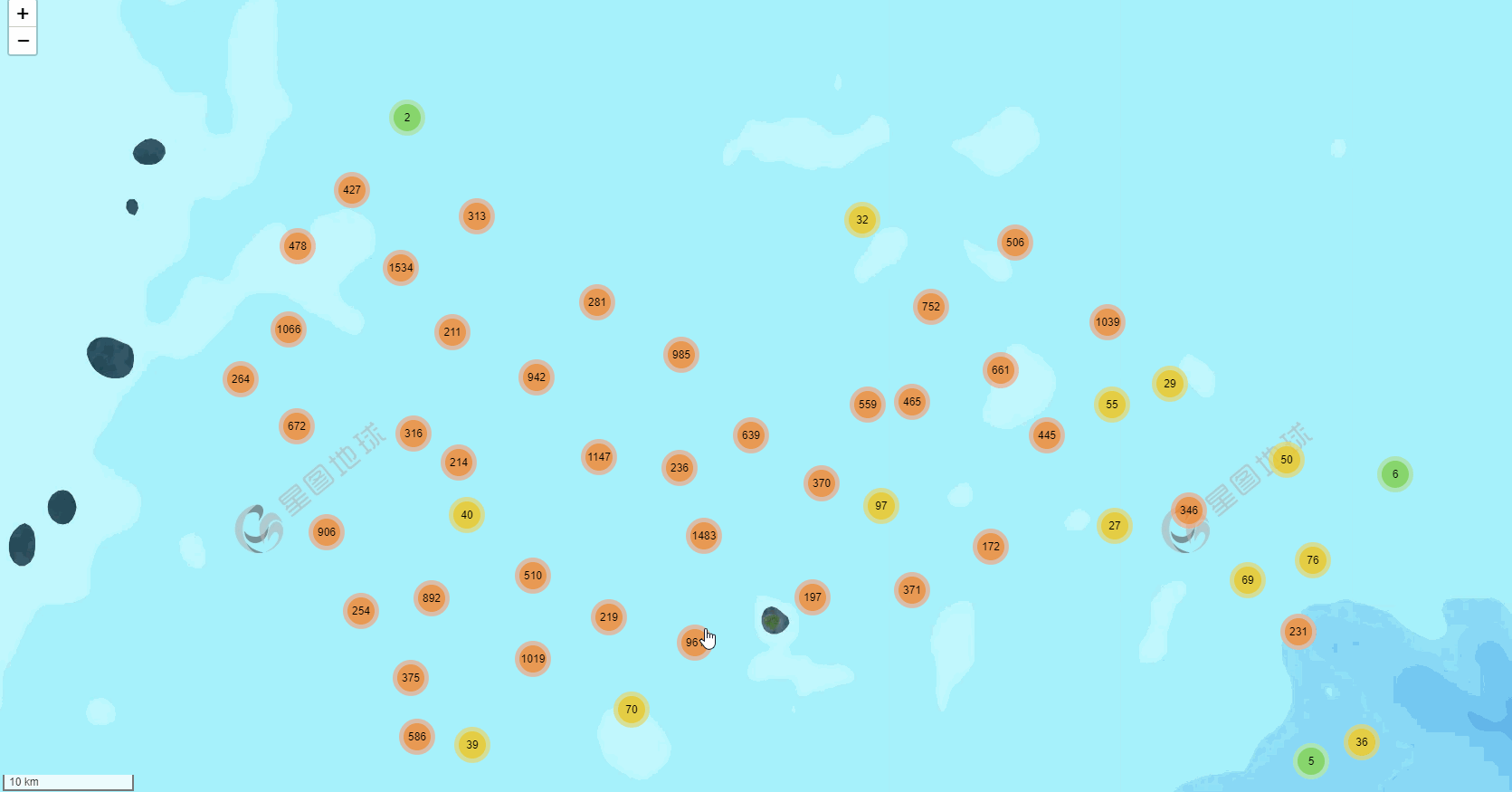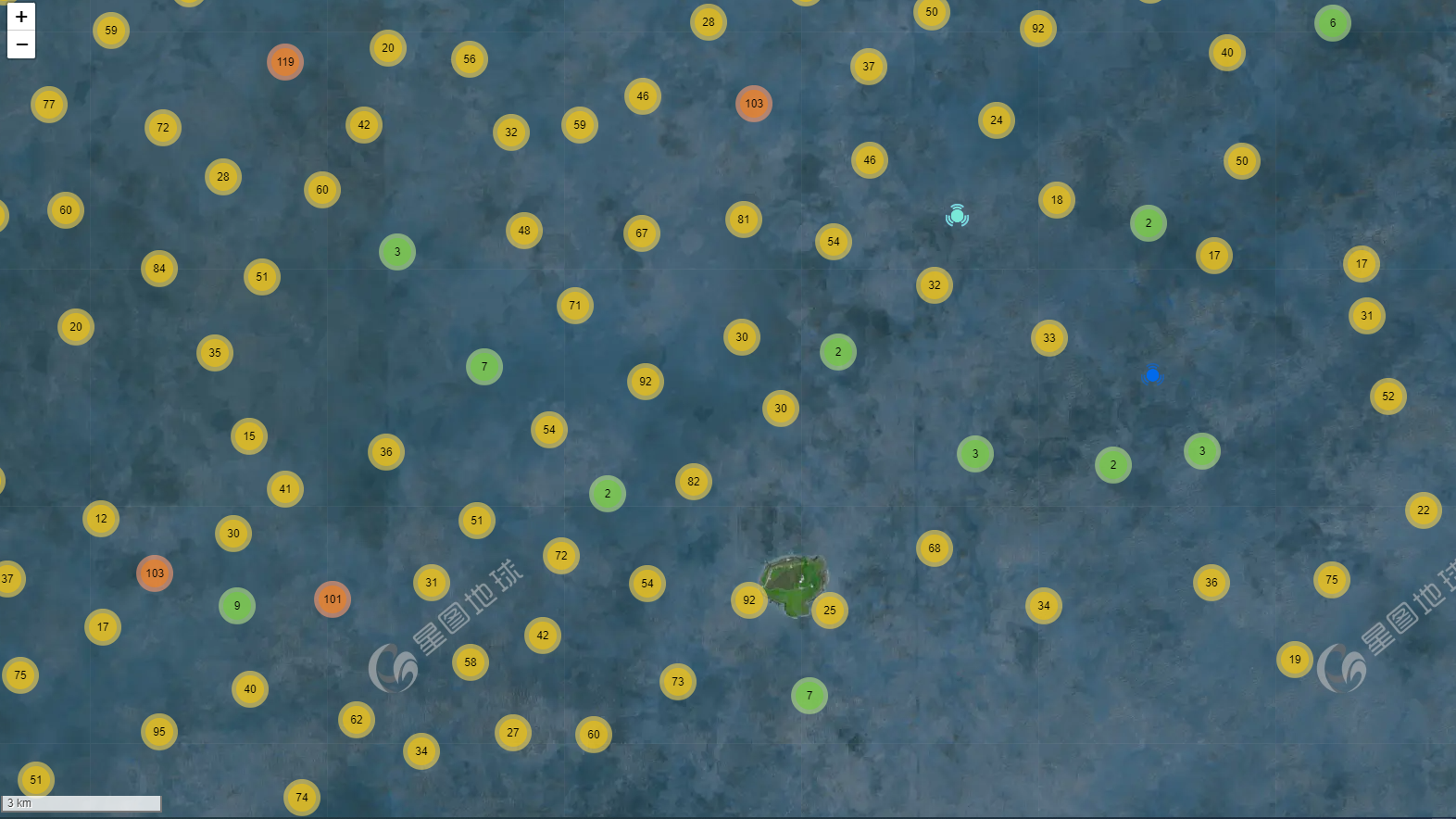vue+leaflet笔记之地图聚合
文章目录
- vue+leaflet笔记之地图聚合
- 开发环境
- 代码简介
- 插件简介与安装
- 使用简介
- 详细源码(Vue3)
本文介绍了Web端使用Leaflet开发库进行地图聚合查询的一种方法 (底图来源:中科星图),结合Leaflet.markercluster插件能够快速的实现地图聚合查询功能,显示效果如下图所示。

开发环境
Vue开发库:3.2.37 & Leaflet开发库:1.9.3
Leaflet主要插件:Leaflet.markercluster
代码简介
插件简介与安装
Leaflet.markercluster是为一个Leaflet提供漂亮的动画标记聚类功能的插件,优点是功能强大、简单易用,建议结合github文档仔细研究下,部分功能由于篇幅有限未列举;缺点是在加载大批量(10w+点数据)层级切换时,有明显的卡顿感。
官方文档 https://github.com/Leaflet/Leaflet.markercluster
# 插件安装
npm install leaflet.markercluster
# 插件安装(国内镜像,速度较快)
npm --registry https://registry.npm.taobao.org install leaflet.markercluster
# 引入地图聚合插件 Leaflet.markercluster
import "leaflet.markercluster/dist/MarkerCluster.css";
import "leaflet.markercluster/dist/MarkerCluster.Default.css";
import "leaflet.markercluster";
使用简介
// 创建新的聚合图层,向其添加标记,然后将其添加到地图中
const markerClusterLayer = L.markerClusterGroup({showCoverageOnHover: false, // 为true时,当鼠标悬停在点上时,它会显示它聚合的边界zoomToBoundsOnClick: true, // 为true时,当鼠标点击某个点时,会缩放到它的边界范围chunkedLoading: true, maxClusterRadius: 80, // 聚类从中心标记覆盖的最大半径(以像素为单位),默认值 80
}).addTo(map);
// 加载待聚合的geojson点数据
let geojson = pointData;
if (geojson) {let markerList = []; // 聚合标记点列表if (geojson.features.length > 0) {for (let i = 0; i < geojson.features.length; i++) {if (geojson.features[i].geometry) {// 属性const properties = geojson.features[i].properties;// 经纬度坐标const coordinate = geojson.features[i].geometry.coordinates;// 点状展示样式(无聚合状态)let img = dot3Url;const myIcon = L.icon({iconUrl: img,iconSize: [25, 25],});// 创建标记点const marker = L.marker(new L.LatLng(coordinate[1], coordinate[0]), {properties: properties,icon: myIcon,});markerList.push(marker);}}}// 添加聚合标记点列表markerClusterLayer.addLayers(markerList);
}
此外,L.markerClusterGroup还提供了几个别的属性:
| 属性 | 默认值 | 说明 | 备注 |
|---|---|---|---|
| showCoverageOnHover | true | 为true时,当鼠标悬停在聚合点上时,它会显示它聚合的边界 | |
| zoomToBoundsOnClick | true | 为true时,当鼠标点击某个聚合点时,会缩放到它的边界范围 | |
| spiderfyOnMaxZoom | true | 为true时,当你在最大缩放级别点击一个聚合点时,会将其蜘蛛化,以便你能看到其包含的所有标记 | |
| chunkedLoading | true | 为true时,将 addLayers 的处理流程拆分成小间隔时间去处理,这样页面不会看起来静止不动 | |
| removeOutsideVisibleBounds | true | 为true时,如果聚合点处于地图的显示区域外,则出于性能考虑将其从地图上移除 | |
| spiderLegPolylineOptions | {…} | 允许定义一个给蜘蛛脚一个多边形选项 PolylineOptions | 实测,无用 |
| maxClusterRadius | 80 | 聚合点从中心标记覆盖的最大半径(以像素为单位) |

详细源码(Vue3)
源代码下载地址 链接:https://pan.baidu.com/s/1axmOSj3cc8ve26_aODISeg?pwd=GIS6
提取码:GIS6
<template><div class="app-contain"><!-- leaflet 地图容器 --><div id="myMap"></div></div>
</template><script setup>
// 本地资源数据
import dot3Url from '/@/assets/images/dot3.png'
// 引入数据
import pointData from '/@/assets/mapData/heatData.json' // 地图聚合数据
// 引入样式
import { onMounted } from 'vue'
import L from 'leaflet';
import 'leaflet/dist/leaflet.css'
// 地图聚合 Leaflet.markercluster(聚合图层)
import "leaflet.markercluster/dist/MarkerCluster.css";
import "leaflet.markercluster/dist/MarkerCluster.Default.css";
import "leaflet.markercluster";
// 星图地球token
let geovisearthToken = 'YOURS_TOKEN'
let map = null;
const initMap = () => {const imagesLayer = L.tileLayer(`https://tiles1.geovisearth.com/base/v1/img/{z}/{x}/{y}?token=${geovisearthToken}`);const imagesLableLayer = L.tileLayer(`https://tiles1.geovisearth.com/base/v1/cia/{z}/{x}/{y}?token=${geovisearthToken}`);const layers = L.layerGroup([imagesLayer, imagesLableLayer])map = L.map('myMap', { //需绑定地图容器div的idcenter: [25.67052, 121.99804], //初始地图中心zoom: 12, //初始缩放等级maxZoom: 20,minZoom: 2,zoomControl: true, //缩放组件attributionControl: false, //去掉右下角logolscrollWheelZoom: true, //默认开启鼠标滚轮缩放// 限制显示地理范围maxBounds: L.latLngBounds(L.latLng(-90, -180), L.latLng(90, 180)),layers: [layers] // 图层})// 添加比例尺要素显示L.control.scale({ maxWidth: 200, metric: true, imperial: false }).addTo(map)/** 地图聚合 */addMapFeature(pointData);
}// 地图聚合
const addMapFeature = (pointData) => {// 创建新的聚合图层,向其添加标记,然后将其添加到地图中const projectPointLayer = L.markerClusterGroup({showCoverageOnHover: false, // 为true时,当鼠标悬停在聚合点上时,它会显示它聚合的边界zoomToBoundsOnClick: true, // 为true时,当鼠标点击某个聚合点时,会缩放到它的边界范围chunkedLoading: true,spiderfyOnMaxZoom: true,maxClusterRadius: 80, // 聚类从中心标记覆盖的最大半径(以像素为单位),默认值 80spiderLegPolylineOptions: { weight: 1, color: '#222', opacity: 0.5 },}).addTo(map);let geojson = pointData;if (geojson) {addProjectClusterLayers(geojson, projectPointLayer);projectPointLayer.on("click", function (e) {e.layer.unbindPopup(); // 用于解除地图图层(layer)与其关联的弹出窗口(popup)// 图层点击弹出窗口处理事件const elements = getProjectPopupContent(e.layer.options.properties); // 返回内容e.layer.bindPopup(elements).openPopup(e.latlng); // 弹窗});}
};/** 点单击内容函数*/
const getProjectPopupContent = (item) => {// 内容及单击事件const elements = `<div>${toPopupItemStr("经度", item.lon)} ${toPopupItemStr("纬度", item.lat)} ${toPopupItemStr("阈值", item.valve)}</div>`;return elements;
};
const toPopupItemStr = (name, value) => {return value ? `<b>${name}:</b>${value}<br>` : "";
};/** 加载聚合图层*/
const addProjectClusterLayers = async (geojson, clusterlayer) => {let markerList = []; // 聚合标记点列表if (geojson.features.length > 0) {for (let i = 0; i < geojson.features.length; i++) {if (geojson.features[i].geometry) {const properties = geojson.features[i].properties;const coordinate = geojson.features[i].geometry.coordinates;/* 点状展示样式(无聚合状态) */let img = dot3Url;const myIcon = L.icon({iconUrl: img,iconSize: [25, 25],});const marker = L.marker(new L.LatLng(coordinate[1], coordinate[0]), {properties: properties,icon: myIcon,});markerList.push(marker);}}}clusterlayer.addLayers(markerList);
};onMounted(() => {initMap()
})
</script><style scoped>
#myMap {width: 92vw;height: 92vh;
}
</style>
- 浮点数的存储)

神经网络与典型的机器学习步骤)






)
:CNN和cifar10)
实测)


)

)

, orr(位或), eor(异或)】)
